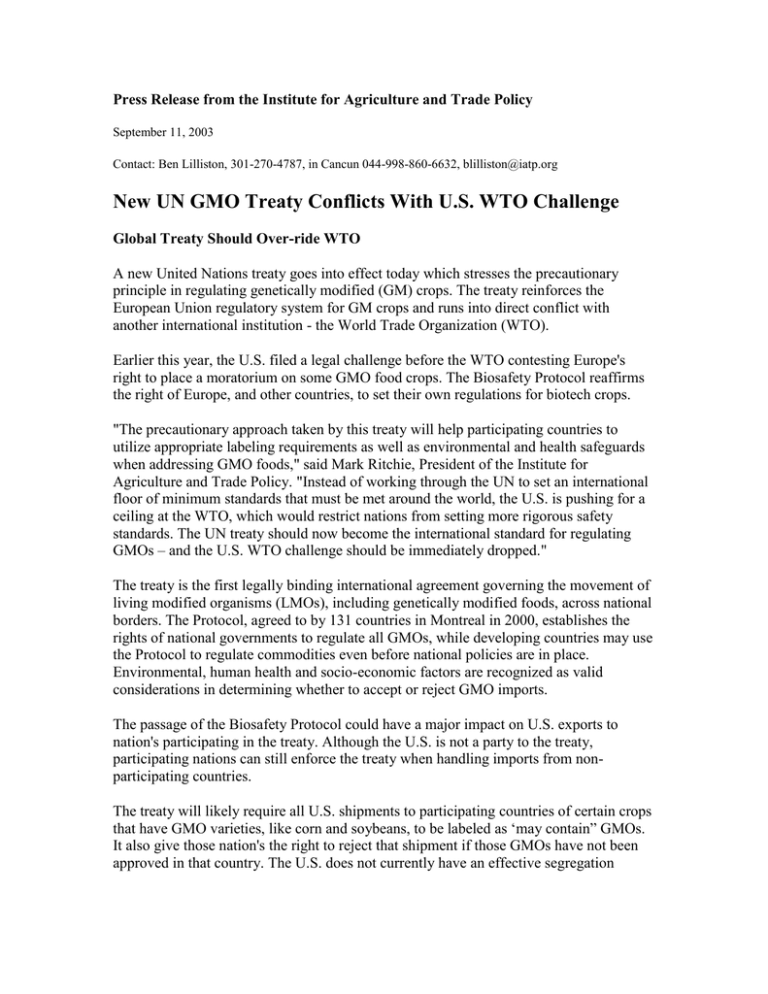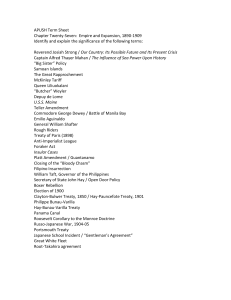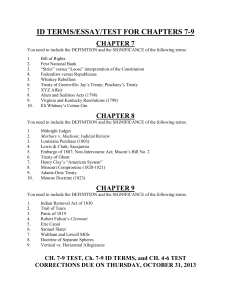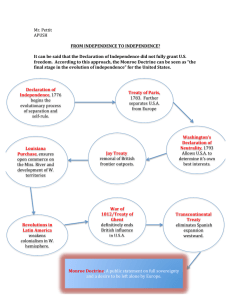Press Release from the Institute for Agriculture and Trade Policy
advertisement

Press Release from the Institute for Agriculture and Trade Policy September 11, 2003 Contact: Ben Lilliston, 301-270-4787, in Cancun 044-998-860-6632, blilliston@iatp.org New UN GMO Treaty Conflicts With U.S. WTO Challenge Global Treaty Should Over-ride WTO A new United Nations treaty goes into effect today which stresses the precautionary principle in regulating genetically modified (GM) crops. The treaty reinforces the European Union regulatory system for GM crops and runs into direct conflict with another international institution - the World Trade Organization (WTO). Earlier this year, the U.S. filed a legal challenge before the WTO contesting Europe's right to place a moratorium on some GMO food crops. The Biosafety Protocol reaffirms the right of Europe, and other countries, to set their own regulations for biotech crops. "The precautionary approach taken by this treaty will help participating countries to utilize appropriate labeling requirements as well as environmental and health safeguards when addressing GMO foods," said Mark Ritchie, President of the Institute for Agriculture and Trade Policy. "Instead of working through the UN to set an international floor of minimum standards that must be met around the world, the U.S. is pushing for a ceiling at the WTO, which would restrict nations from setting more rigorous safety standards. The UN treaty should now become the international standard for regulating GMOs – and the U.S. WTO challenge should be immediately dropped." The treaty is the first legally binding international agreement governing the movement of living modified organisms (LMOs), including genetically modified foods, across national borders. The Protocol, agreed to by 131 countries in Montreal in 2000, establishes the rights of national governments to regulate all GMOs, while developing countries may use the Protocol to regulate commodities even before national policies are in place. Environmental, human health and socio-economic factors are recognized as valid considerations in determining whether to accept or reject GMO imports. The passage of the Biosafety Protocol could have a major impact on U.S. exports to nation's participating in the treaty. Although the U.S. is not a party to the treaty, participating nations can still enforce the treaty when handling imports from nonparticipating countries. The treaty will likely require all U.S. shipments to participating countries of certain crops that have GMO varieties, like corn and soybeans, to be labeled as ‘may contain” GMOs. It also give those nation's the right to reject that shipment if those GMOs have not been approved in that country. The U.S. does not currently have an effective segregation system between GMO and non-GMO - so it is unclear how this new treaty will be implemented by U.S. shippers and importing countries. On September 11, 2003, certain provisions of the Treaty will take effect immediately: Countries shipping LMOs for intentional introduction into the environment will have to give prior notification of the first shipment to an importing country that is a party to the Protocol under what is referred to as the "Advance Informed Agreement" procedure. Sufficient information will have to be provided to enable importing countries to make informed decisions on whether to accept the shipment. Member countries of the Protocol will also be required to use the Biosafety Clearinghouse (BCH) to fulfill a number of specific obligations. The BCH is a largely Internet-based facility established under the Protocol to ease communications and exchange of information between the Parties. All shipments containing LMOs for intentional introduction into the environment will be clearly identified as such in the accompanying documentation which must specify the identity and characteristics of the specific LMOs contained in each shipment. The Institute for Agriculture and Trade Policy promotes resilient family farms, rural communities and ecosystems around the world through research and education, science and technology, and advocacy. ##





